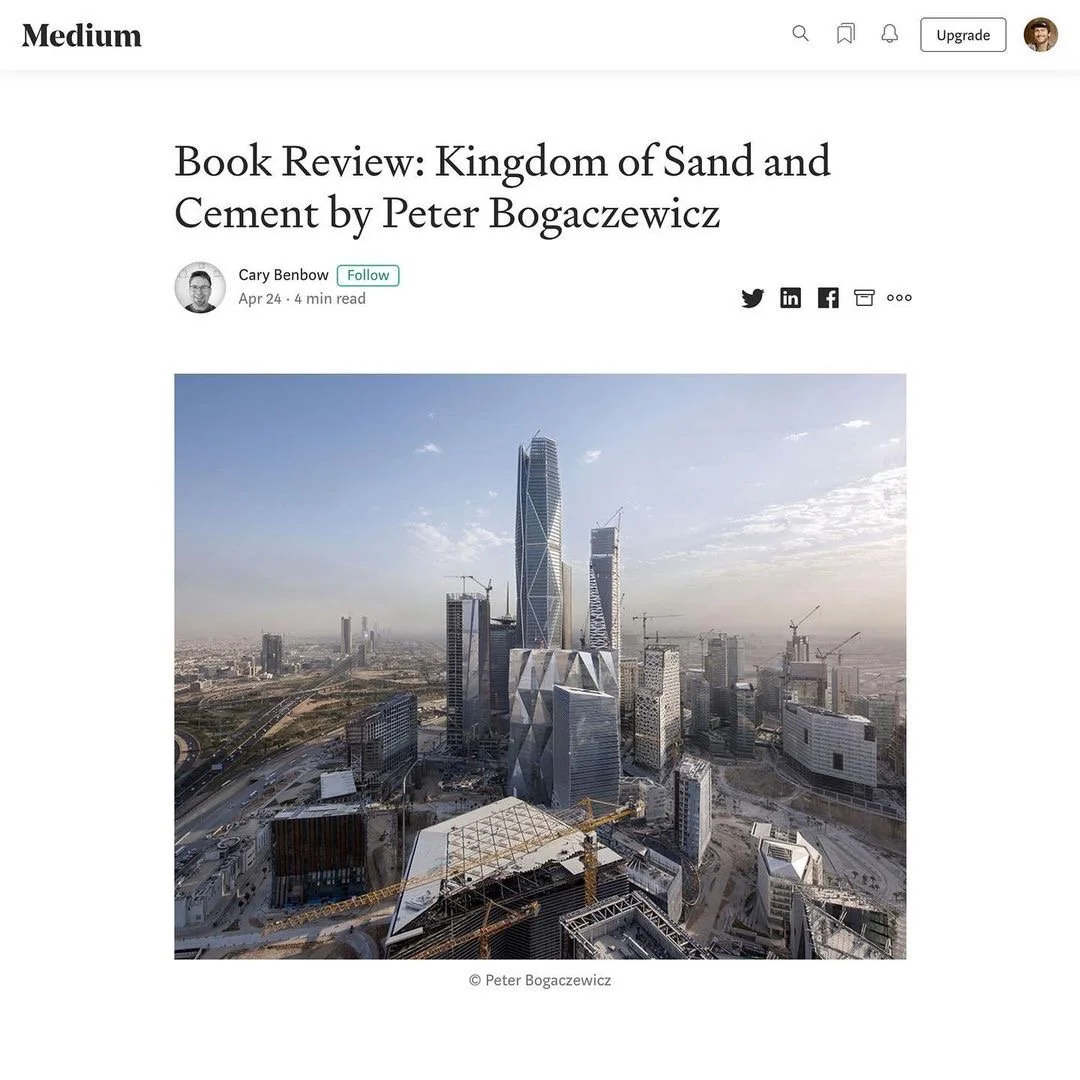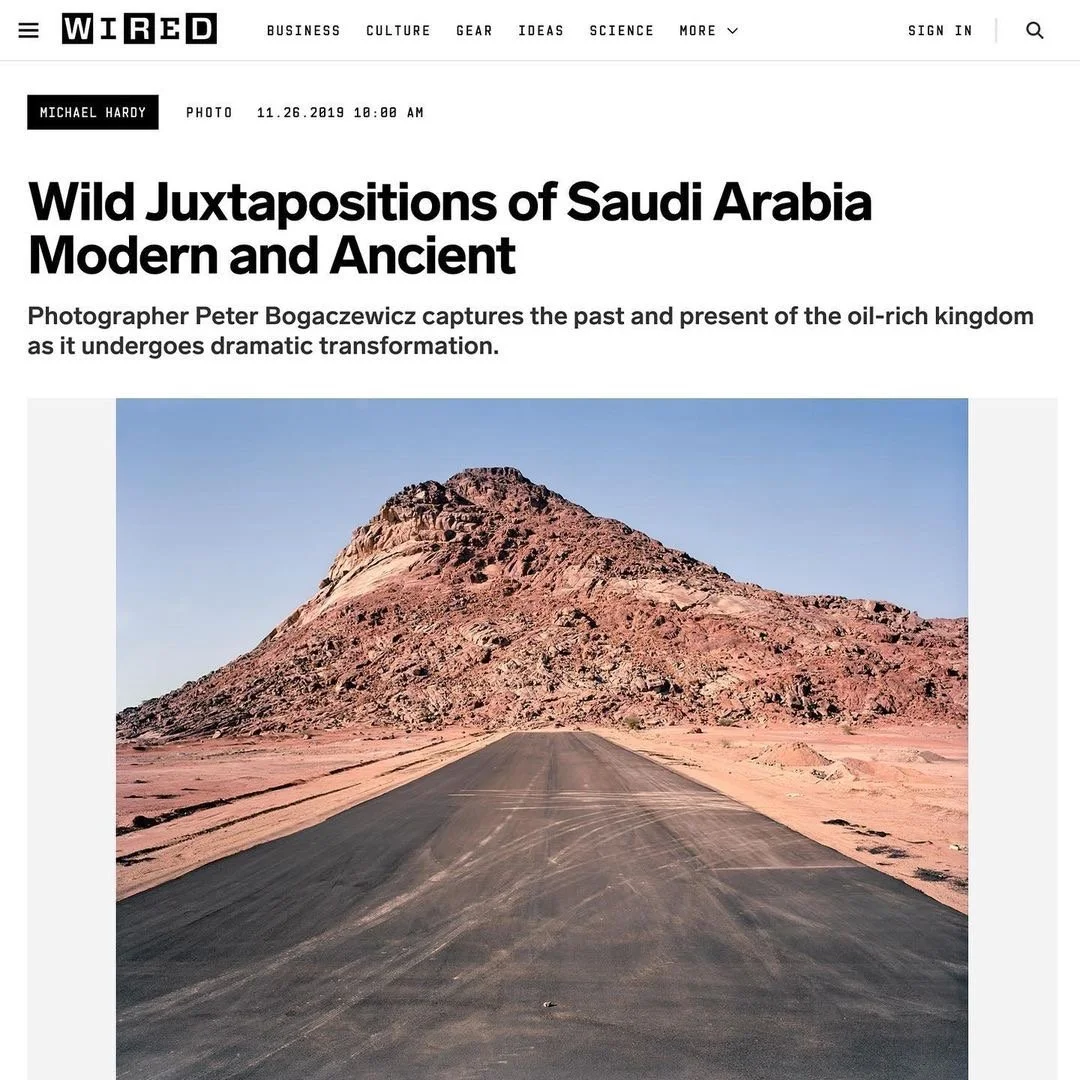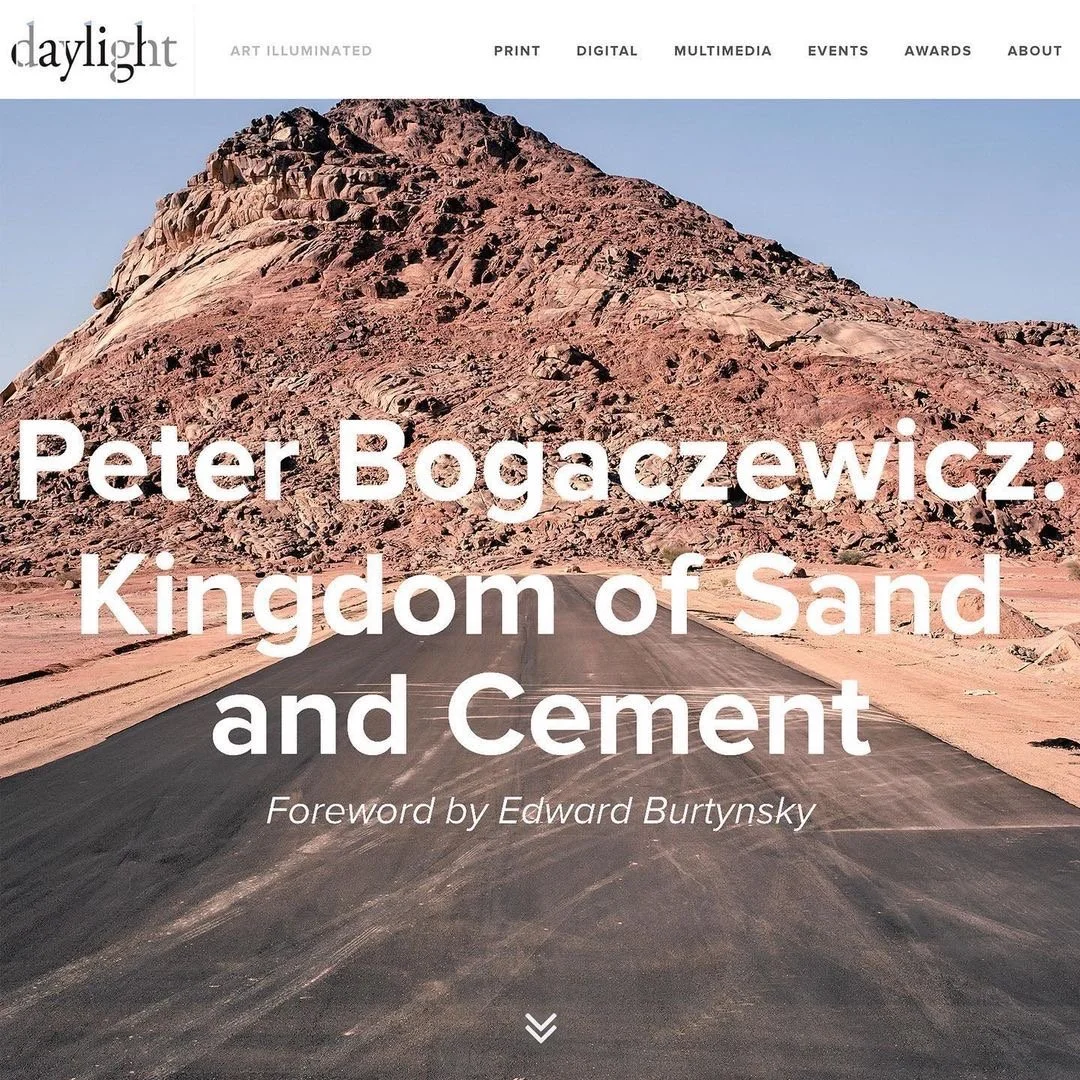From, Book Review: Kingdom of Sand and Cement by Peter Bogaczewicz, Medium / F-Stop Magazine, by Cary Benbow
Saudi Arabia, and the Saudis, have experienced profound change in less than a century as they transitioned from living in traditional mud buildings to commencing work on the world’s tallest skyscraper. Kingdom of Sand and Cement by Peter Bogaczewicz explores the challenges Saudi Arabia faces today as it rapidly transforms from a conservative and tribal desert culture to an influential world power.
Examining this legacy through beautiful large-format color photographs, Bogaczewicz documents a country and a society in the midst of an unprecedented change; and the clash of its traditional and modern values reveals a society precariously balancing at a crossroads of old and new. His images of the contemporary landscape are contrasted against Saudi traditional buildings, homes, and culture. Bogaczewicz examines the traces of an ancient culture right up to the point of intersection between the built and the natural environment. He presents the question: does this rapid and often careless pace of change run the chance to lose a sense of cultural identity—and a lasting and damaging consequence to the environment?…
This brings me back to Bogaczewicz’s question—certainly lives are being disrupted or ruined by losses of both natural resources and cultural sources. He captures evocative images of children and families eating and sitting next to an ancient city wall, camel trails switchback across a steep hillside, ancient islamic buildings crumble before our eyes—and structures of glass, concrete and steel rise high above their humble earthen origins. We see the roads carved into, or completely through, previously untouched landscapes. He also shows us images of people living in traditional ways, as well as modern ways: Burqas and bicycles, mosques and motorbikes, a family enjoying their midday meal, sitting on rugs spread out in the shade of a concrete overpass. The current era of globalization has a homogenizing influence on local cultures, which in turn can lead to loss of identity, exclusion and even conflict. Bogaczewicz’s insightful work explores and ultimately highlights the impact made in Saudi Arabia when people don’t fully consider placing culture and the environment at the heart of development.
From, Wild Juxtapositions of Saudi Arabia Modern and Ancient, WIRED Magazine, by Michael Hardy
Few countries in history have experienced as sudden a transformation as Saudi Arabia. Until the founding of the modern state by the Saud family in the early 20th century, the vast Arabian Peninsula was inhabited mainly by nomadic groups living a traditional lifestyle that hadn’t changed much in thousands of years. The discovery and exploitation of oil brought an unprecedented influx of wealth that, almost overnight, catapulted the country into the top echelon of the world’s economies. That affluence, combined with traditional values, has led to some of the country’s most compelling apparent paradoxes.
“Development happened so fast that they haven’t really had a chance to keep up with it the way other societies have,” says Peter Bogaczewicz a Canadian architect and photographer who has lived in the Saudi Arabian capital of Riyadh for the past five years. Examples of the country’s mixture of tradition and modernity are everywhere in Bogaczewicz’s new book, including its title: Kingdom of Sand and Cement. Bogaczewicz has spent the past half-decade traveling the country, initially out of a desire to document historic sites threatened by the rapid pace of development. During that time, he photographed abandoned villages disappearing back into the desert as well as 10,000-year-old petroglyphs.
“The petroglyphs are just these rocks at the side of the road,” he says. “You can drive off the highway and a couple hundred meters away you’re faced with this amazing scene. Anywhere else you’d have a museum built around it. Here, there were just a few people scratching their names into the side.” As part of Crown Prince Mohammed bin Salman’s effort to promote Saudi Arabian tourism, the country is now working to preserve some historic sites. But countless others—including some documented in Bogaczewicz’s book—have already been destroyed in the country’s rush to modernize.
In other ways, though, Saudis manage to hold onto their cultural past. On weekends, many young men drive their cars out to the desert to go off-roading, slaloming down the sides of sand dunes as spectators watch. Another of Bogaczewicz’s photographs captures a Saudi family having a picnic under a highway overpass, much as their bedouin ancestors might have stopped their caravansary by a desert wadi to have a meal… As Saudi Arabia slowly opens up to the world, it seems likely that the country is in store for even more dramatic transformation over the next century.
From, Peter Bogaczewicz: Kingdom of Sand and Cement, Daylight Books, foreword by Edward Burtynsky
Gazing into the images of Peter Bogaczewicz we are transported to a relatively isolated part of our planet, a place where by virtue of the gifts of the Earth people live an extraordinary and fortunate life. In seeing the world the Saudis have constructed for themselves and the marks they have left behind we are able to form a deeper understanding of their values…
Bogaczewicz has pried open a crack, allowing us to peer into this ultra wealthy hermit kingdom, and through bearing witness with his camera we are offered a glimpse into what this previously nomadic culture is up to. With his background as an architect he finds a path that leads him through the fragile, historic abandoned sites that are yielding to time and the elements. We find ourselves looking at the hyper-speed modernization of an ancient culture—massive infrastructure projects, glimmering glass and steel towers on the horizon, luxury shopping centers and brand new suburbs provided to a growing middle class.
Through Peter’s lens we are given access to the evolution of an ancient culture, and it’s transformation into a contemporary landscape both in its architecture and its revision of cultural mores. However, the new Arabian edifices are poorly suited to the intense heat of the land, and exist in stark juxtaposition to the country’s fragile historic sites and a disappearing way of life. Instead they co-exist with discarded plastics, tires, and refuse accumulating in the creases of both city and countryside. In his eloquent images, Peter Bogaczewicz continually returns to the built environment, and a reborn country that still appears on it’s surface like a backdrop to a uniquely privileged life, but is not exempt from the familiar and inevitable modern dichotomy of growth versus waste.




